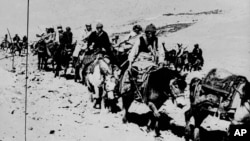Chinese authorities in the Tibet Autonomous Region (TAR) appear to be trying out a new, softer approach to winning over the loyalty of Tibetans while continuing to arrest those who protest.
The party chief in TAR, Chen Quanguo, has begun meeting and exchanging letters with monks from restive areas, especially Driru County, the site of several anti-Beijing protests in recent years.
While a military presence continues in the restive areas, analysts say Chen appears to be engaged in a more personal approach to dealing with unrest.
“I think what we are seeing is, in some ways, what Chen Quanguo is doing is new,” said Professor Carole McGranahan of Colorado University. “This is a technique that we haven't seen from Chinese politicians for a long time.”
Chen’s predecessor Zhang Qingli took a very hard line position on Tibetan religion and called the Dalai Lama “a jackal in Buddhist monk’s robes; an evil spirit with a human face.” But Chen has chosen not to attack the Tibetan spiritual leader with derogatory names.
Robert Barnett, director of modern Tibet Studies Program at Columbia University, says China’s main focus since Chen took over TAR leadership from Zhang has been trying to win the hearts and minds of the people.
“Every thing we see in policy, especially since 2011, is about trying to win over the masses,” Barnett said. “I think sending the leaders to monasteries and nunneries is part of this realization that the communist party now has to win over the masses, especially the monasteries, which have an important role with the masses.”
Professor McGranahan says this is similar to the tactic China used when it first took over Tibet in the early 1950s.
However, the message being delivered by the softer approach appears to be a variation of the same message Beijing has been sending for six decades.
According to an article published in the official Tibet Daily, he wrote to monks in 2013 to tell them “forever raise the patriotic flag high and single-mindedly support the party and the government, and make a clear separation from the 14th Dalai Lama clique."
Unrest has become more visible in recent years, with protests becoming more widespread. Since 2009, at least 126 Tibetans have self-immolated. Their common message was for the return of the Dalai Lama to Tibet and freedom for Tibetan people.
Chinese authorities blamed the Dalai Lama and “outside forces” for the self-immolations in Tibet, which the Dalai Lama and the Tibetan government in exile have repeatedly denied.
This report was produced in collaboration with the VOA Tibetan service.
The party chief in TAR, Chen Quanguo, has begun meeting and exchanging letters with monks from restive areas, especially Driru County, the site of several anti-Beijing protests in recent years.
While a military presence continues in the restive areas, analysts say Chen appears to be engaged in a more personal approach to dealing with unrest.
“I think what we are seeing is, in some ways, what Chen Quanguo is doing is new,” said Professor Carole McGranahan of Colorado University. “This is a technique that we haven't seen from Chinese politicians for a long time.”
Chen’s predecessor Zhang Qingli took a very hard line position on Tibetan religion and called the Dalai Lama “a jackal in Buddhist monk’s robes; an evil spirit with a human face.” But Chen has chosen not to attack the Tibetan spiritual leader with derogatory names.
Robert Barnett, director of modern Tibet Studies Program at Columbia University, says China’s main focus since Chen took over TAR leadership from Zhang has been trying to win the hearts and minds of the people.
“Every thing we see in policy, especially since 2011, is about trying to win over the masses,” Barnett said. “I think sending the leaders to monasteries and nunneries is part of this realization that the communist party now has to win over the masses, especially the monasteries, which have an important role with the masses.”
Professor McGranahan says this is similar to the tactic China used when it first took over Tibet in the early 1950s.
However, the message being delivered by the softer approach appears to be a variation of the same message Beijing has been sending for six decades.
According to an article published in the official Tibet Daily, he wrote to monks in 2013 to tell them “forever raise the patriotic flag high and single-mindedly support the party and the government, and make a clear separation from the 14th Dalai Lama clique."
Unrest has become more visible in recent years, with protests becoming more widespread. Since 2009, at least 126 Tibetans have self-immolated. Their common message was for the return of the Dalai Lama to Tibet and freedom for Tibetan people.
Chinese authorities blamed the Dalai Lama and “outside forces” for the self-immolations in Tibet, which the Dalai Lama and the Tibetan government in exile have repeatedly denied.
This report was produced in collaboration with the VOA Tibetan service.






